Abstract
Background:
Stress has been found to significantly reduce the abilities of the immune system to fight infections. One of the ways to overcome the defects of the immune system is the strengthening of the defense reactions by nutrition.
Aims:
To evaluate immune enhancing effects of the following material: WB365, a novel combination of Ashwagandha (Withania somnifera) and Maitake (Grifola frondosa) extracts.
Results:
We found that both glucan-rich maitake extract and WB365 caused a similar stimulation of phagocytic activity. Stress-induced increase of corticosterone production was blocked by feeding with Ashwagandha extract and even more by WB365. Cytokine experiments showed that feeding with WB365 helped overcome the stress-related inhibition of IL-6, IL-12 and IFN-γ production.
Conclusion:
This study clearly demonstrated that WB365, a combination of Maitake mushroom-derived glucan and Ashwagandha extracts, has strong pleiotropic biological effects related to immune health and stress reduction.
Keywords: Glucan, stress, immunomodulator, cytokines
Introduction
Immune health is affected by a number of factors including diet, exercise, sleep or environmental factors[1]. More recently, stress has been found to significantly reduce the ability of our immune system to fight infections[2]. One of the ways to overcome the defects of the immune system is the strengthening of the defense reactions by nutrition[3]. The idea of supporting immune health through supplementation with nutraceutical ingredients is not only more and more popular, but also supported by clinical studies[4]. One of the most effective immune boosting agents is β1,3-glucan.
β1,3-Glucans are structurally complex homopolymers of glucose, usually isolated from yeast or fungi. β1,3-Glucan's role as a biologically active immunomodulator has been well-documented for more than 50 years. Interest in the immunomodulatory properties of polysaccharides was initially raised after experiments showing that a crude yeast cell preparation stimulated macrophages[5]. Subsequent studies identified the immunomodulatory active component as β1,3-glucan[6]. β-Glucans show notable biological effects; this is their most important quality and the reason why so much attention has been focused on them. Numerous studies have subsequently shown that β1,3-glucans, either particulate or soluble, exhibit immunostimulating properties, including antibacterial and anti-tumor activities[7,8].
Recently, glucans were found to have even stronger activities when used simultaneously with various biologically active molecules such as vitamin C[9], resveratrol[10] or humic acids[11]. In addition to their ability to boost various components of the innate and adaptive immune systems, glucans exhibit mild anti-stress properties[12,13]. Based on these data, we decided to compare the effects of well-established glucan-rich Maitake mushroom extract (MTG)[14] to WSE, a standardized extract of Ashwagandha (Withania somnifera) with known stress-reducing effects[15], and WB365, a proprietary nutraceutical composed of both MTG and WSE.
Ashwagandha is an adaptogenic botanical grown in India that is revered for its ability to balance, energize, rejuvenate, and revitalize. WSE's stress-reducing characteristics result from unique withanolide bioactive compounds that are extracted from specially cultivated Ashwagandha roots and leaves in a patented, water-based process. These bioactives mimic the body's own stress-reducing hormones and give WSE adaptogenic properties.
Materials and Methods
Animals
Female, 8 week old BALB/c mice were purchased from the Jackson Laboratory (Bar Harbor, ME). All animal work was done according to the University of Louisville IACUC protocol. Animals were sacrificed by CO2 asphyxiation. Nine mice were used in each experiment.
β-1,3 glucans
MTG is soluble glucan-rich extract isolated from Maitake fruit body (Grifola frondosa). The product, which is a glucan/protein complex, is derived by thermally extracting the fruit body of Maitake with water under pressure at 100°C or more for 30 minutes to an hour. After that, alcohol is added to the extract at a final concentration of 20 to 60% by volume to remove floating material by filtration. The resulting extract is concentrated under heating to remove residual alcohol. The product is a hygroscopic powder in shades of brown which is soluble in water, alkaline solutions and dimethyl sulphoxide, with a molecular weight around 1,000 kD. MTG is produced by Yukiguni Maitake Co. (Niigata, Japan) and for this project was purchased from Tradeworks Group, Inc. (Brattleboro, Vermont).
WSE
WSE is derived from a withaferin A and corresponding withanolide glycoside-predominant Ashwagandha chemotype grown in central and northern regions of India. Root and leaf material is processed using a water-based extraction process, standardized to a minimum of 8% withanolide glycosides and 32% oligosaccharides, and a maximum of 2% free Withanolides (as Withaferin A), and tested using high performance thin layer chromatography analysis. WSE is produced by Natreon, Inc. (New Brunswick, New Jersey) and for this study was purchased from NutraGenesis, LLC. (Brattleboro, Vermont).
WB365
WB365 is a novel nutraceutical mixture consisting of a combination of glucan-rich MTG and stress-reducing WSE in a ratio of 1:16.67 weight to weight, respectively.
Oral Treatment
Mice were treated orally twice/day for 14 days with either 30.75 μg/mouse/day of MTG, 512.5 μg/mouse/day of WSE, 543.25 μg/mouse/day of WB365 (containing 30.75 μg of MTG and 512.5 μg of WSE) or PBS control.
Phagocytosis
The technique employing phagocytosis of synthetic polymeric microspheres was described earlier [16,17]. Briefly: peripheral blood cells were incubated with 0.05 ml of 2-hydroxyethyl methacrylate particles (HEMA; 5×108 /ml). The test tubes were incubated at 37°C for 60 min., with intermittent shaking. Smears were stained with Wright stain. The neutrophils with three or more HEMA particles were considered positive.
Cold stress protocol
Mice were subjected to cold stress by daily incubation for 60 min at 4°C for two weeks[18]. For the same time interval, mice were orally treated with tested substances.
Cytokine production
Purified spleen cells (2×106/ml in RPMI 1640 medium with 5% FCS) were added into wells of a 24-well tissue culture plate. After addition of 1 μg of Concanavalin A, cells were incubated for 48 hrs. in a humidified incubator (37°C, 5% CO2). At the endpoint of incubation, supernatants were collected, filtered through 0.45 μm filters and tested for the presence of IL-6, IL-12 and IFN-γ. Levels of individual cytokines were measured using a Quantikine mouse IL-6, IL-12 or IFN-γ kit (R&D Systems, Minneapolis, MN).
Measurement of serum corticosterone
On day 14, blood samples were collected by venipuncture from mice under pentobarbital anesthesia. Obtained sera were collected and stored at -80°C before assay. Serum corticosterone was measured using an ELISA kit (Diagnostics Systems Lab, TX) according to the manufacturer's instructions.
Results
β-Glucans are considered to be potent stimulators of cellular immunity, with macrophages and neutrophils being the most important targets. Therefore, we first focused on the role of glucan in stress-related changes in phagocytic activity. We used the synthetic polymeric microspheres (HEMA), since their use, dose and timing are already well established in glucan studies[19].
WSE has been shown to be safe in previous testing. In short-term mouse toxicity studies, there was no mortality up to doses of 5 g/kg, confirming that LD50 does not lie within 5 g/kg in mice. In sub-chronic oral toxicity studies, WSE was without adverse effects in doses up to 300 mg/kg in mice for 90 days. Both studies were performed by an independent laboratory (Indian Herbs Research Supply, Saharanpur, India). In addition, tests performed by BSL Bioservice (Planegg, Germany) showed no toxic effects of WSE in any of the five tester strains of Salmonella typhimurium at doses up to 5, 000 μg/plate.
The results summarized in Figure 1 show that both glucan-rich MTG and WB365 caused a similar, significant stimulation of phagocytic activity of blood neutrophils of control mice. The effects of WB365 are most likely caused by its MTG component, as WSE alone had no effect. The increase caused by MTG in the control group was expected and corresponds to previously published data. In the stress group, cold stress caused a significant (25%) decrease in phagocytic activity. While WSE showed an ability to return phagocytosis to a normal level, mice fed with samples of MTG alone and WB365 showed the same phagocytic activity as the mice without the stress.
Fig. 1.
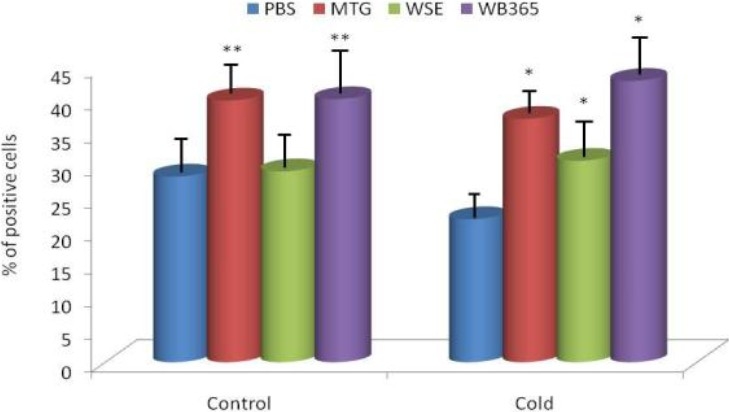
Effect of 14 days of oral feeding on phagocytosis by mouse peripheral blood granulocytes. *Represents significant differences between stressed and control animals at P ≤0.05 level. **Represents significant differences between PBS and tested substances in the control group at P ≤0.05 level.
Next, we measured the level of corticosterone in serum. In the control group, feeding with tested material did not alter the level of corticosterone. On the other hand, cold-related stress resulted in a significant increase of corticosterone production in the PBS control, which was blocked by feeding with WSE and even more by WB365 (Figure 2).
Fig. 2.
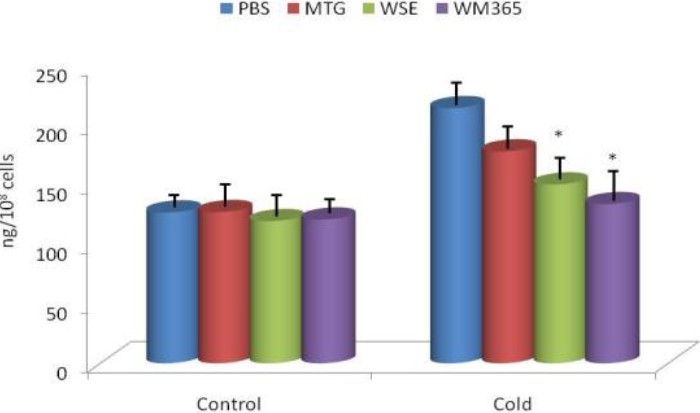
Effect of 14 days of oral feeding on levels of corticosterone. *Represents significant differences between stressed and control animals at P ≤0.05 level.
The basal production of IL-6 by Con A-stimulated splenocytes was low (10 pg/106 cells) and was significantly increased by feeding with MTG and WB365. Stress almost completely inhibited IL-6 secretion, which was restored by all three tested samples. However, only WB365 strongly increased the level of IL-6 well above control levels (Figure 3).
Fig. 3.
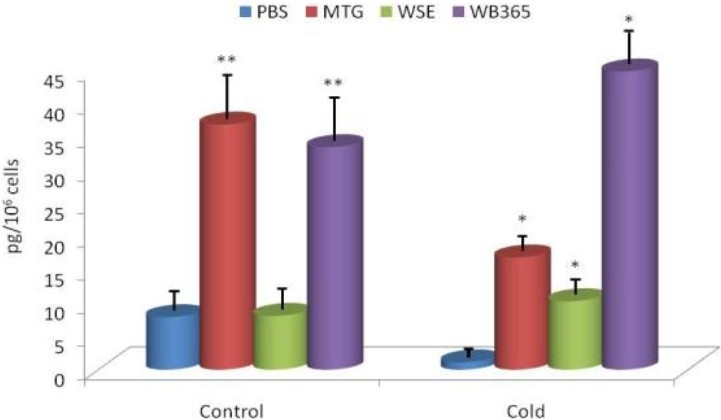
Effect of 14 days of oral feeding on levels of IL-6. *Represents significant differences between stressed and control animals at P ≤0.05 level. **Represents significant differences between PBS and tested substances in the control group at P ≤0.05 level.
Similar results were obtained in the case of IL-12 except that both WB365 and WSE showed very strong stimulation of IL-12 production (Figure 4). In the case of IFN-γ, stress reduced secretion of this cytokine but both WB365 and WSE showed the ability to return IFN-γ levels to what was observed in stress-inhibited animals (Figure 5).
Fig. 4.
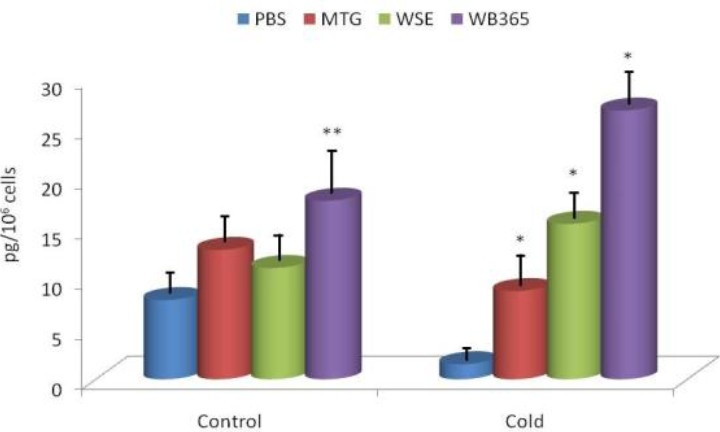
Effect of 14 days of oral feeding on levels of IL-12. *Represents significant differences between stressed and control animals at P ≤0.05 level. **Represents significant differences between PBS and tested substances in the control group at P ≤0.05 level.
Fig. 5.
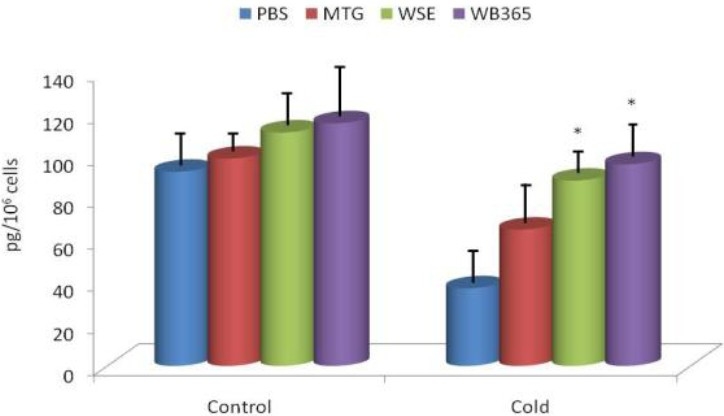
Effect of 14 days of oral feeding on levels of IFN-γ. *Represents significant differences between stressed and control animals at P ≤0.05 level.
Discussion
In this paper, we evaluated the immune-enhancing and stress-reducing effects of WB365 versus its individual components, MTG and WSE. Despite the fact that glucan is primarily considered to be both nonspecific and specific stimulator of immunity, more and more papers are recently suggesting additional biological roles for this natural modulator. Among functions such as reduction of cholesterol levels[20] or accelerated regeneration after bone marrow damage by irradiation or chemotherapy[21], glucan was also shown to reduce stress[12,13]. The present study affirmed that glucan-rich MTG as well as MTG-containing WB365 have immune boosting properties in both stressed and unstressed environments.
Previous studies of WSE have demonstrated its stress reducing properties. In a randomized, double-blind, placebo-controlled human clinical trial in which 125 mg WSE was taken twice daily for 60 days, a strong 69.9% reduction in stress and a 24.2% reduction in serum cortisol has been found[15]. In addition, WSE was also found to have positive effects on swim-induced stress[22]. The present study confirmed these significant stress-reducing properties.
The effects of stress on the immune reaction are well established and are presumed to occur via the hypothalamic-pituitary-adrenal axis[23] with corticosterone playing the major role[24]. Due to the fact that glucan is a well-known immunomodulator and MTG is a glucan-rich extract, we started our study by testing phagocytosis. We used the synthetic polymeric microspheres HEMA, since their use, dose and timing are already well established in glucan studies[19]. Compared to control values, cold stress significantly decreased the phagocytic activity. All tested samples increased the stress-induced suppression of phagocytosis, with WB365 having the highest activity. Whereas MTG is responsible for the increase in phagocytosis (see control group), the stress-related inhibition was restored more with WSE and WB365, suggesting that these effects are mediated more by the WSE.
In addition to the direct effect on various cells of the immune system, the immunostimulating action of β-glucans is caused by increased release of various cytokines such as TNFα, IFN-γ, and/or IL-2. This cytokine-stimulating activity is dependent on numerous factors such as molecular weight, and the triple helix conformation[7]. In our study we focused on three different cytokines, IL6, IL-12 and IFN-γ, all of which were previously found to be affected by cold- and restrain-inducing stress[13].
These three cytokines represent a wide variety of the cytokine network, as they differ in their source and biological role. Whereas IL-6 is a pleiotropic cytokine produced by a variety of cells and IFN-γ is a cytokine critical for both innate and adaptive immunity, IL-12 is primarily secreted by macrophages. However, in stressful conditions they have one common characteristic – they are all reduced. The treatment with MTG managed to return the secretion of IL-6 and IL-12 to normal value while WB365 completely blocked the stress-related inhibition of cytokine secretion. These effects were stronger than in the case of MTG alone or four different glucan types used previously[25].
A significant increase in corticosterone levels after experimentally-induced stress is in agreement with previous studies[12]. MTG or WSE alone helped reverse this effect, but the best results were obtained with WB365, which returned corticosterone levels back to normal based on its superior ability to regulate the negative effects of stress.
Conclusion
This study clearly demonstrates that WB365, a proprietary combination of Maitake mushroom-derived glucan and Ashwagandha extracts, has strong pleiotropic biological effects related to immune health and stress reduction. These include increasing cytokine levels and phagocytosis, as well as reducing corticosterone levels. For some of the investigated variables, results for WB365 were greater than what was expected based on the results of the individual components, indicating a strong synergistic effect between glucan and withanolide bioactives. Additional work is necessary to establish the mechanisms of how MTG and WSE bioactives act synergistically to regulate the negative effects of stress and improve immune health.
Conflict of Interest
The authors are not employed by any of the companies manufacturing products used in this paper nor have any financial interests in these companies.
References
- 1.Cohen S, Frank E, Doyle WJ, et al. Types of stressors that increase susceptibility to the common cold in healthy adults. Health Psychol. 1998;17:214–223. doi: 10.1037//0278-6133.17.3.214. [DOI] [PubMed] [Google Scholar]
- 2.Agarwal SK, Marshal GD., Jr Stress effects on immunity and its application to clinical immunology. Clin Exp Allergy. 2001;31:25–31. [PubMed] [Google Scholar]
- 3.Wichers H. Immunomodulation by food: promising concept for mitigating allergic disease? Anal Bioanal Chem. 2009;395:37–45. doi: 10.1007/s00216-009-2838-1. [DOI] [PMC free article] [PubMed] [Google Scholar]
- 4.Bhaskamar P. Micronutrient malnurition, infection, and immunity.An Overview. Nutrition Rev. 2002;60:S40–S45. doi: 10.1301/00296640260130722. [DOI] [PubMed] [Google Scholar]
- 5.Benacerraf B, Sebestyen MM. Effect of bacterial endotoxins on the reticuloendothelial system. Fed Proc. 1957;16:860–867. [PubMed] [Google Scholar]
- 6.Rigi SJ, Di Luzio NR. Identification of a reticuloendothelial stimulating agent in zymosan. Am J Physiol. 1961;200:297–300. doi: 10.1152/ajplegacy.1961.200.2.297. [DOI] [PubMed] [Google Scholar]
- 7.Novak M, Vetvicka V. Beta-glucans, history and the present: Immunomodulatory aspects and mechanisms of action. J Immunotoxicol. 2008;5:47–57. doi: 10.1080/15476910802019045. [DOI] [PubMed] [Google Scholar]
- 8.Novak M, Vetvicka V. Glucans as biological response modifiers. Endocrine Metabol. Immune Disorders-Drug Targets. 2009;9:67–75. doi: 10.2174/187153009787582423. [DOI] [PubMed] [Google Scholar]
- 9.Verlhac V, Obach A, Gabaudan J, et al. Immunomodulation by dietary vitamin C and glucan in rainbow trout (Oncorhynchus mykiss) Fish Shellfish Immunol. 1988;8:409–424. [Google Scholar]
- 10.Vetvicka V, Volny T, Saraswat-Ohri S, et al. Glucan and resveratrol complex- possible synergistic effects on immune system. Biomed Pap. 2007;151:41–46. doi: 10.5507/bp.2007.007. [DOI] [PubMed] [Google Scholar]
- 11.Vetvicka V, Baigorri R, Zamarreno AM, et al. Glucan and humic acids: synergistic effects on immune system. J Med Food. 2010;13:863–869. doi: 10.1089/jmf.2009.0178. [DOI] [PubMed] [Google Scholar]
- 12.Kimura Y, Sumiyoshi M, Suziki T, et al. Effects of water-soluble low-molecular-weight β-1,3-D-glucan (branch β-1,6) isolated from Aureobasidium pullulans 1A1 strain black yeast on restrain stress in mice. Pharmacy Pharmacol. 2007;59:1137–1144. doi: 10.1211/jpp.59.8.0012. [DOI] [PubMed] [Google Scholar]
- 13.Vetvicka V, Vancikova Z. Anti-stress action of several orally-given β-glucans. Biomed Pap. 2010;154:235–238. doi: 10.5507/bp.2010.035. [DOI] [PubMed] [Google Scholar]
- 14.Vetvicka V, Vetvickova J. Immunostimulating properties of two different β-glucans isolated from Maitake mushrooms (Grifola frondosa) JANA. 2005;8:33–39. [Google Scholar]
- 15.Auddy B, Hazra J, Mitra A, et al. A standardized Withania somnifera extract significantly reduces stress-related parameters in chronically stressed humans: a double-blind, randomized, placebo-controlled study. JANA. 2008;11:50–56. [Google Scholar]
- 16.Vetvicka V, Fornusek L, Kopecek J, et al. Phagocytosis of human blood leukocytes: A simple micromethod. Immunol Lett. 1982;5:97–100. doi: 10.1016/0165-2478(82)90040-2. [DOI] [PubMed] [Google Scholar]
- 17.Vetvicka V, Holub M, Kováru H, et al. Alpha-fetoprotein and phagocytosis in athymic nude mice. Immunol Lett. 1987;19:95–98. doi: 10.1016/0165-2478(88)90125-3. [DOI] [PubMed] [Google Scholar]
- 18.Jainu M, Devi CSS. Antiulcerogenic and ulcer healing effects of Solanum nigrum (L.,) on experimental ulcer models: Possible mechanism for the inhibition of acid formation. J Ethnopharmacol. 2006;104:156–63. doi: 10.1016/j.jep.2005.08.064. [DOI] [PubMed] [Google Scholar]
- 19.Vetvicka V, Yvin J-C. Effects of marine β-glucan on immune reaction. Int Immunopharmacol. 2004;4:721–730. doi: 10.1016/j.intimp.2004.02.007. [DOI] [PubMed] [Google Scholar]
- 20.Wilson TA, Nicolosi RJ, Delaney B, et al. Reduced and high molecular weight barley beta-glucans decrease plasma total and non-HDL-cholesterol in hypercholesterolemic Syrian golden hamsters. J Nutr. 2004;134:2617–2622. doi: 10.1093/jn/134.10.2617. [DOI] [PubMed] [Google Scholar]
- 21.Patchen ML, MacVittie TJ. Comparative effects of soluble and particulate glucans on survival in irradiated mice. J Biol Response Mod. 1986;5:45–60. [PubMed] [Google Scholar]
- 22.Bhattacharyya S, Pal D, Banerjee D, et al. Comparative effects of Withania somnifera and Panax ginseng on swim-stress induced impaired energy status in mice. Pharmacologyonline. 2009;2:421–432. [Google Scholar]
- 23.Riley V. Psychoneuroendocrine influences on immune competence and neoplasia. Science. 1981;212:1100–1109. doi: 10.1126/science.7233204. [DOI] [PubMed] [Google Scholar]
- 24.Dhabhar FS, Miller AH, Stein M, et al. Diurnal and acute stress-induced changesin distribution of peritoneal blood leukocyte subpopulations. Brain Behav Immunol. 1994;8:66–79. doi: 10.1006/brbi.1994.1006. [DOI] [PubMed] [Google Scholar]
- 25.Vetvicka V, Vetvickova J. β1,3-glucan: Silver buller or hot air? Open Glycoscience. 2010;3:1–6. [Google Scholar]


